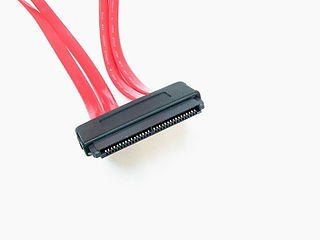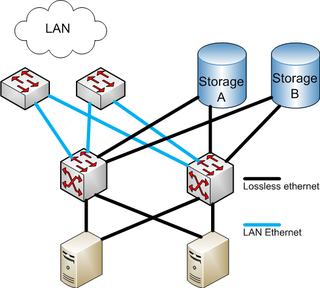Related Research Articles

Small Computer System Interface is a set of standards for physically connecting and transferring data between computers and peripheral devices. The SCSI standards define commands, protocols, electrical, optical and logical interfaces. The SCSI standard defines command sets for specific peripheral device types; the presence of "unknown" as one of these types means that in theory it can be used as an interface to almost any device, but the standard is highly pragmatic and addressed toward commercial requirements. The initial Parallel SCSI was most commonly used for hard disk drives and tape drives, but it can connect a wide range of other devices, including scanners and CD drives, although not all controllers can handle all devices.
Internet Small Computer Systems Interface or iSCSI is an Internet Protocol-based storage networking standard for linking data storage facilities. iSCSI provides block-level access to storage devices by carrying SCSI commands over a TCP/IP network. iSCSI facilitates data transfers over intranets and to manage storage over long distances. It can be used to transmit data over local area networks (LANs), wide area networks (WANs), or the Internet and can enable location-independent data storage and retrieval.
Fibre Channel (FC) is a high-speed data transfer protocol providing in-order, lossless delivery of raw block data. Fibre Channel is primarily used to connect computer data storage to servers in storage area networks (SAN) in commercial data centers.

In computer hardware, a host controller, host adapter, or host bus adapter (HBA), connects a computer system bus, which acts as the host system, to other network and storage devices. The terms are primarily used to refer to devices for connecting SCSI, Fibre Channel and SATA devices. Devices for connecting to IDE, Ethernet, FireWire, USB and other systems may also be called host adapters.
In computer science and networking in particular, a session is a time-delimited two-way link, a practical layer in the tcp/ip protocol enabling interactive expression and information exchange between two or more communication devices or ends – be they computers, automated systems, or live active users. A session is established at a certain point in time, and then ‘torn down’ - brought to an end - at some later point. An established communication session may involve more than one message in each direction. A session is typically stateful, meaning that at least one of the communicating parties needs to hold current state information and save information about the session history to be able to communicate, as opposed to stateless communication, where the communication consists of independent requests with responses.
In computer storage, a logical unit number, or LUN, is a number used to identify a logical unit, which is a device addressed by the SCSI protocol or by Storage Area Network protocols that encapsulate SCSI, such as Fibre Channel or iSCSI.

In computing, Serial Attached SCSI (SAS) is a point-to-point serial protocol that moves data to and from computer-storage devices such as hard disk drives and tape drives. SAS replaces the older Parallel SCSI bus technology that first appeared in the mid-1980s. SAS, like its predecessor, uses the standard SCSI command set. SAS offers optional compatibility with Serial ATA (SATA), versions 2 and later. This allows the connection of SATA drives to most SAS backplanes or controllers. The reverse, connecting SAS drives to SATA backplanes, is not possible.
In computer data storage, a SCSI initiator is the endpoint that initiates a SCSI session, that is, sends a SCSI command. The initiator usually does not provide any Logical Unit Numbers (LUNs).

The arbitrated loop, also known as FC-AL, is a Fibre Channel topology in which devices are connected in a one-way loop fashion in a ring topology. Historically it was a lower-cost alternative to a fabric topology. It allowed connection of many servers and computer storage devices without using then very costly Fibre Channel switches. The cost of the switches dropped considerably, so by 2007, FC-AL had become rare in server-to-storage communication. It is however still common within storage systems.
ATA over Ethernet (AoE) is a network protocol developed by the Brantley Coile Company, designed for simple, high-performance access of block storage devices over Ethernet networks. It is used to build storage area networks (SANs) with low-cost, standard technologies.
In Fibre Channel protocol, a registered state change notification (RSCN) is a Fibre Channel fabric's notification sent to all specified nodes in case of any major fabric changes. This allows nodes to immediately gain knowledge about the fabric and react accordingly.
A clustered file system is a file system which is shared by being simultaneously mounted on multiple servers. There are several approaches to clustering, most of which do not employ a clustered file system. Clustered file systems can provide features like location-independent addressing and redundancy which improve reliability or reduce the complexity of the other parts of the cluster. Parallel file systems are a type of clustered file system that spread data across multiple storage nodes, usually for redundancy or performance.
Host-based zoning can include WWN or LUN masking, and is typically known as “persistent binding.”

On Linux, network block device (NBD) is a network protocol that can be used to forward a block device from one machine to a second machine. As an example, a local machine can access a hard disk drive that is attached to another computer.

Fibre Channel over Ethernet (FCoE) is a computer network technology that encapsulates Fibre Channel frames over Ethernet networks. This allows Fibre Channel to use 10 Gigabit Ethernet networks while preserving the Fibre Channel protocol. The specification was part of the International Committee for Information Technology Standards T11 FC-BB-5 standard published in 2009.
In computing the SCSI RDMA Protocol (SRP) is a protocol that allows one computer to access SCSI devices attached to another computer via remote direct memory access (RDMA). The SRP protocol is also known as the SCSI Remote Protocol. The use of RDMA makes higher throughput and lower latency possible than what is generally available through e.g. the TCP/IP communication protocol.

A storage area network (SAN) or storage network is a computer network which provides access to consolidated, block-level data storage. SANs are primarily used to access data storage devices, such as disk arrays and tape libraries from servers so that the devices appear to the operating system as direct-attached storage. A SAN typically is a dedicated network of storage devices not accessible through the local area network (LAN).
iSCSI conformance testing is testing to determine whether an iSCSI Initiator/Target meets the iSCSI standard.

In computing, Linux-IO (LIO) Target is an open-source implementation of the SCSI target that has become the standard one included in the Linux kernel. Internally, LIO does not initiate sessions, but instead provides one or more Logical Unit Numbers (LUNs), waits for SCSI commands from a SCSI initiator, and performs required input/output data transfers. LIO supports common storage fabrics, including FCoE, Fibre Channel, IEEE 1394, iSCSI, iSCSI Extensions for RDMA (iSER), SCSI RDMA Protocol (SRP) and USB. It is included in most Linux distributions; native support for LIO in QEMU/KVM, libvirt, and OpenStack makes LIO also a storage option for cloud deployments.

SCST is a GPL licensed SCSI target software stack. The design goals of this software stack are high performance, high reliability, strict conformance to existing SCSI standards, being easy to extend and easy to use. SCST does not only support multiple SCSI protocols but also supports multiple local storage interfaces and also storage drivers implemented in user-space via the scst_user driver.
References
- ↑ Tseng, J.; Gibbons, K.; Travostino, F.; Du, C.; Souza, J. (2005). "RFC 4171: Internet Storage Name Service (iSNS)". doi:10.17487/RFC4171.
{{cite journal}}: Cite journal requires|journal=(help)